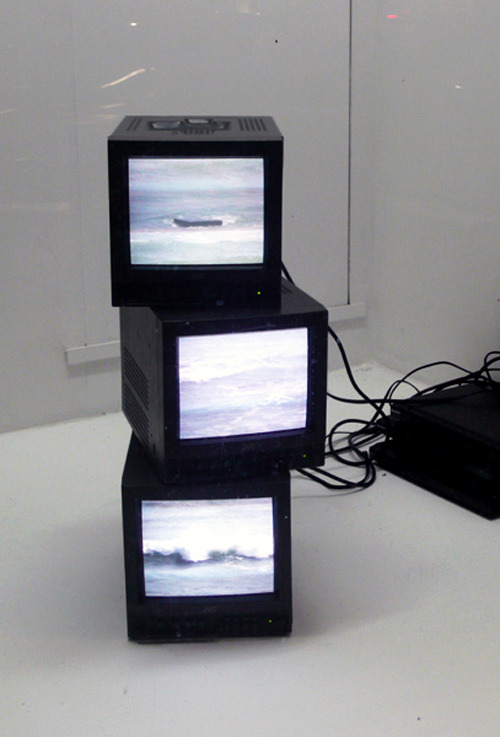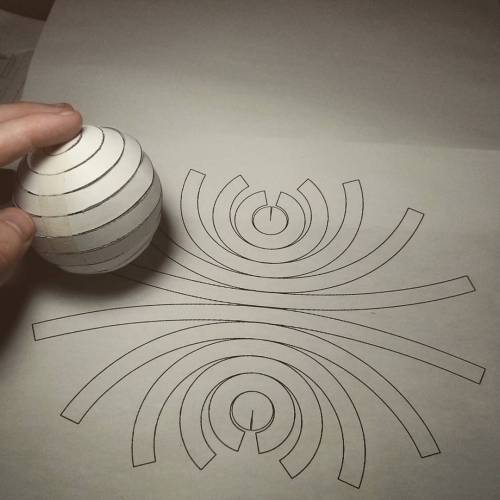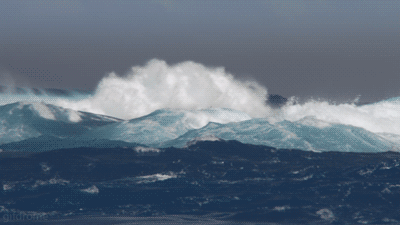Hannahhaifisch - HH

More Posts from Hannahhaifisch and Others








Cindermedusae - making generative creatures



David Spriggs, Dark Matter.

Quantum tunnelling
Tunneling is a quantum mechanical effect. A tunneling current occurs when electrons move through a barrier that they classically shouldn’t be able to move through. In classical terms, if you don’t have enough energy to move “over” a barrier, you won’t. However, in the quantum mechanical world, electrons have wavelike properties. These waves don’t end abruptly at a wall or barrier, but taper off quickly. If the barrier is thin enough, the probability function may extend into the next region, through the barrier! Because of the small probability of an electron being on the other side of the barrier, given enough electrons, some will indeed move through and appear on the other side. When an electron moves through the barrier in this fashion, it is called tunneling.

Quantum mechanics tells us that electrons have both wave and particle-like properties. Tunneling is an effect of the wavelike nature.

The top image shows us that when an electron (the wave) hits a barrier, the wave doesn’t abruptly end, but tapers off very quickly - exponentially. For a thick barrier, the wave doesn’t get past.
The bottom image shows the scenario if the barrier is quite thin (about a nanometer). Part of the wave does get through and therefore some electrons may appear on the other side of the barrier.
Because of the sharp decay of the probability function through the barrier, the number of electrons that will actually tunnel is very dependent upon the thickness of the barrier. The current through the barrier drops off exponentially with the barrier thickness
Source: nanoscience.com | Images: x | x | x

Can you flatten a sphere?
The answer is NO, you can not. This is why all map projections are innacurate and distorted, requiring some form of compromise between how accurate the angles, distances and areas in a globe are represented.
This is all due to Gauss’s Theorema Egregium, which dictates that you can only bend surfaces without distortion/stretching if you don’t change their Gaussian curvature.
The Gaussian curvature is an intrinsic and important property of a surface. Planes, cylinders and cones all have zero Gaussian curvature, and this is why you can make a tube or a party hat out of a flat piece of paper. A sphere has a positive Gaussian curvature, and a saddle shape has a negative one, so you cannot make those starting out with something flat.
If you like pizza then you are probably intimately familiar with this theorem. That universal trick of bending a pizza slice so it stiffens up is a direct result of the theorem, as the bend forces the other direction to stay flat as to maintain zero Gaussian curvature on the slice. Here’s a Numberphile video explaining it in more detail.
However, there are several ways to approximate a sphere as a collection of shapes you can flatten. For instance, you can project the surface of the sphere onto an icosahedron, a solid with 20 equal triangular faces, giving you what it is called the Dymaxion projection.
The Dymaxion map projection.
The problem with this technique is that you still have a sphere approximated by flat shapes, and not curved ones.
One of the earliest proofs of the surface area of the sphere (4πr2) came from the great Greek mathematician Archimedes. He realized that he could approximate the surface of the sphere arbitrarily close by stacks of truncated cones. The animation below shows this construction.
The great thing about cones is that not only they are curved surfaces, they also have zero curvature! This means we can flatten each of those conical strips onto a flat sheet of paper, which will then be a good approximation of a sphere.
So what does this flattened sphere approximated by conical strips look like? Check the image below.
But this is not the only way to distribute the strips. We could also align them by a corner, like this:
All of this is not exactly new, of course, but I never saw anyone assembling one of these. I wanted to try it out with paper, and that photo above is the result.
It’s really hard to put together and it doesn’t hold itself up too well, but it’s a nice little reminder that math works after all!
Here’s the PDF to print it out, if you want to try it yourself. Send me a picture if you do!

Watching the clouds go by on #Mars. Check out these atmospheric ripples!


Agate
Locality: Rio Grande do Sul, Brazil

-
 initialsemes liked this · 6 years ago
initialsemes liked this · 6 years ago -
 reishbit reblogged this · 7 years ago
reishbit reblogged this · 7 years ago -
 coup-contrecoup reblogged this · 7 years ago
coup-contrecoup reblogged this · 7 years ago -
 flea-bath-forever reblogged this · 7 years ago
flea-bath-forever reblogged this · 7 years ago -
 heiskiiwii liked this · 7 years ago
heiskiiwii liked this · 7 years ago -
 thischristianguy liked this · 7 years ago
thischristianguy liked this · 7 years ago -
 coup-contrecoup reblogged this · 7 years ago
coup-contrecoup reblogged this · 7 years ago -
 helloiamgeek liked this · 7 years ago
helloiamgeek liked this · 7 years ago -
 bricklyhq-blog reblogged this · 7 years ago
bricklyhq-blog reblogged this · 7 years ago -
 brattbug liked this · 7 years ago
brattbug liked this · 7 years ago -
 terroristghoul reblogged this · 7 years ago
terroristghoul reblogged this · 7 years ago -
 borokhemk-blog liked this · 7 years ago
borokhemk-blog liked this · 7 years ago -
 naisuki-uwu liked this · 8 years ago
naisuki-uwu liked this · 8 years ago -
 higlyglamorous reblogged this · 8 years ago
higlyglamorous reblogged this · 8 years ago -
 anxiousnini reblogged this · 8 years ago
anxiousnini reblogged this · 8 years ago -
 choerris reblogged this · 8 years ago
choerris reblogged this · 8 years ago -
 samanthalefox liked this · 8 years ago
samanthalefox liked this · 8 years ago -
 vagtastic96 liked this · 8 years ago
vagtastic96 liked this · 8 years ago -
 codezilla reblogged this · 8 years ago
codezilla reblogged this · 8 years ago -
 mcsmarti liked this · 8 years ago
mcsmarti liked this · 8 years ago -
 chazchica reblogged this · 8 years ago
chazchica reblogged this · 8 years ago -
 chazchica liked this · 8 years ago
chazchica liked this · 8 years ago -
 elucidator-yay liked this · 8 years ago
elucidator-yay liked this · 8 years ago -
 myszakon liked this · 8 years ago
myszakon liked this · 8 years ago -
 bonesandpoemsandflowers liked this · 8 years ago
bonesandpoemsandflowers liked this · 8 years ago -
 lady--divine reblogged this · 8 years ago
lady--divine reblogged this · 8 years ago -
 flashdoggy liked this · 8 years ago
flashdoggy liked this · 8 years ago -
 soulless-blunder liked this · 8 years ago
soulless-blunder liked this · 8 years ago -
 lady--divine liked this · 8 years ago
lady--divine liked this · 8 years ago -
 sirskia liked this · 8 years ago
sirskia liked this · 8 years ago -
 ragazzascarafaggio liked this · 8 years ago
ragazzascarafaggio liked this · 8 years ago -
 finder-of-things reblogged this · 8 years ago
finder-of-things reblogged this · 8 years ago -
 finder-of-things liked this · 8 years ago
finder-of-things liked this · 8 years ago -
 ultraswissarmywife reblogged this · 8 years ago
ultraswissarmywife reblogged this · 8 years ago -
 theoldsmelly liked this · 8 years ago
theoldsmelly liked this · 8 years ago